Vladivostok
| Vladivostok (English) Владивосток (Russian) |
|
|---|---|
| — Inhabited locality — | |
 View of Vladivostok and the Golden Horn Bay |
|
.svg.png) Location of Primorsky Krai in Russia |
|
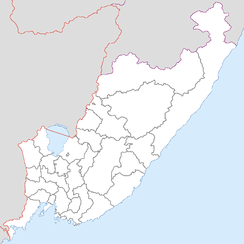 Vladivostok
|
|
| Coordinates: | |
| Holiday | First Sunday of July |
| Administrative status | |
| Country | Russia |
| Federal subject | Primorsky Krai |
| Administrative center of | Primorsky Krai |
| Municipal status | |
| Urban okrug | Vladivostok Urban Okrug |
| Head | Igor Pushkaryov |
| Representative body | Duma |
| Statistics | |
| Area | 600 km2 (230 sq mi) |
| Population (2002 Census) | 594,701 inhabitants[1] |
| - Rank | 23rd |
| - Density | 991 /km2 (2,570 /sq mi)[2] |
| Population (2010) | 578,000 inhabitants[3] |
| Time zone | VLAT/VLAST (UTC+10/+11) |
| Founded | July 2, 1860 |
| Postal code(s) | 690xxx |
| Dialing code(s) | +7 4232 |
| Official website | |
Vladivostok (Russian: Владивосто́к) is Russia's largest port city on the Pacific Ocean and the administrative center of Primorsky Krai. It is situated at the head of the Golden Horn Bay, not far from Russia's border with China and North Korea. It is the home port of the Russian Pacific Fleet. The population of the city, as of 2010, is 578,000.[3]
Contents |
Names
The name Vladivostok (Владивосток) loosely translates from Russian as "possess the East", a name similar to Vladikavkaz which means "possess the Kavkaz". In mainland China (PRC), it is known under the transliteration Fúlādíwòsītuōkè (符拉迪沃斯托克) even though its traditional Chinese name Hǎishēnwǎi (海參崴), meaning "sea cucumber cliffs", is still sometimes used in mainland China [4] and Taiwan as well.[5] The Japanese name of the city is Urajiosutoku (ウラジオストク; a rough transliteration of the Russian originally written in Kanji as 浦塩斯徳 and often shortened to Urajio; ウラジオ; 浦塩). In Korean, the name is transliterated as Beulladiboseutokeu (블라디보스토크) in South Korea, Ullajibosŭttokhŭ (울라지보스또크) in North Korea, and Beullajiboseu-ttokeu (블라지보스또크) by Koreans in China.
History
The territory on which modern Vladivostok is located had been part of many nations, such as Balhae, Jurchen, the Mongol Empire, and China, before Russia acquired the entire Maritime Province and the island of Sakhalin by the Treaty of Aigun (1858). China, which had just lost the Opium War with Britain, was unable to act to maintain the region. The Pacific coast near Vladivostok was settled mainly by the Chinese, Jurchens, Manchus and Koreans during the Imperial Chinese Qing dynasty period. A French whaler visiting the Zolotoy Rog in 1852 discovered Chinese or Manchu village fishermen on the shore of the bay.
The naval outpost was founded in 1859 by Count Nikolay Muravyov-Amursky, who named it on the model of Vladikavkaz, a Russian fortress in the Caucasus. An elaborate system of fortifications was erected between the 1870s and 1890s. A telegraph line from Vladivostok to Shanghai and Nagasaki was opened in 1871, the year when a commercial port was relocated to this town from Nikolayevsk-on-Amur. Town status was granted on April 22, 1880. The municipal coat of arms, representing the Siberian tiger, was adopted in March 1883.
The city's economy was given a boost in 1903, with the completion of the Trans-Siberian Railway which connected Vladivostok to Moscow and Europe. The first high school was opened in 1899. In the wake of the Bolshevik Revolution, Vladivostok was of great military importance for the Far Eastern Republic, the Provisional Priamurye Government, and the Allied intervention, consisting of foreign troops from Japan, the United States, Canada, Czechoslovakia, and other lands.[6] The taking of the city by Ieronim Uborevich's Red Army on 25 October 1922 marked the end of the Russian Civil War.
As the main naval base of the Soviet Pacific Fleet, the city was closed to foreigners during the Soviet years. Nevertheless, it was at Vladivostok that Leonid Brezhnev and Gerald Ford conducted the Strategic Arms Limitation Talks in 1974. At the time, the two countries decided quantitative limits on various nuclear weapons systems and banned the construction of new land-based ICBM launchers.
In December 2008 there were protests in Vladivostok against higher import duties on used cars with the main slogan "Putin, resign!" This may be the first visible public anger at one of the government's responses to the global financial crisis. Police clad in riot gear detained some protesters as other demonstrators blocked roads, lit flares and bonfires in Sunday protests that blocked traffic in the city centre. A separate protest later blockaded the city's airport for a short period. [7]
In June 2010, a Stalin-era mass grave was discovered by road workers which contains some 3.5 tonnes of bones. Nearly all of the skulls have bullet wounds.[8]
Geography
| Vladivostok [9] | ||||||||||||||||||||||||||||||||||||||||||||||||||||||||||||
|---|---|---|---|---|---|---|---|---|---|---|---|---|---|---|---|---|---|---|---|---|---|---|---|---|---|---|---|---|---|---|---|---|---|---|---|---|---|---|---|---|---|---|---|---|---|---|---|---|---|---|---|---|---|---|---|---|---|---|---|---|
| Climate chart () | ||||||||||||||||||||||||||||||||||||||||||||||||||||||||||||
|
||||||||||||||||||||||||||||||||||||||||||||||||||||||||||||
|
||||||||||||||||||||||||||||||||||||||||||||||||||||||||||||
The city is located in the southern extremity of Muravyov-Amursky Peninsula, which is about 30 km long and approximately 12 km wide.
The highest point is Mount Kholodilnik, the height of which is 257 m. Eagle's Nest Mount is often called the highest point of the city; however, with the height of only 199 m (214 m according to other sources), it is the highest point of the downtown area, but not of the whole city.
Vladivostok shares the same or approximate latitude with Sapporo, Sukhumi, Almaty, Florence, Marseille, La Coruña, Boston, and Toronto.
Railroad distance to Moscow is 9,302 km. The direct distance to Moscow is 6,430 km. Direct distance to Bangkok is 5,600 km, to Darwin—6,180 km, San Francisco—8,400 km, Lisbon—10,100 km, London—8,500 km, to Seoul—750 km, to Tokyo—1,050 km, to Beijing—1,331 km.
Climate
- Mean annual temperature: 4.8 °C (40.6 °F)
- Average temperature in January: −13.2 °C (8.2 °F)
- Average temperature in August: 20.6 °C (69.1 °F)
- Average annual precipitation: 799 mm (31.5 in) (strong summer maximum)
- Köppen climate classification: Dwb (monsoon-influenced humid continental climate, warm summers)
| Climate data for Vladivostok | |||||||||||||
|---|---|---|---|---|---|---|---|---|---|---|---|---|---|
| Month | Jan | Feb | Mar | Apr | May | Jun | Jul | Aug | Sep | Oct | Nov | Dec | Year |
| Record high °C (°F) | 5.0 (41) |
9.9 (49.8) |
15.2 (59.4) |
22.7 (72.9) |
29.5 (85.1) |
31.8 (89.2) |
33.6 (92.5) |
33.0 (91.4) |
30.0 (86) |
23.4 (74.1) |
17.5 (63.5) |
9.4 (48.9) |
33.6 (92.5) |
| Average high °C (°F) | -9.3 (15.3) |
-5.9 (21.4) |
1.2 (34.2) |
8.8 (47.8) |
14.2 (57.6) |
17.0 (62.6) |
21.1 (70) |
23.3 (73.9) |
19.6 (67.3) |
12.9 (55.2) |
2.9 (37.2) |
-5.9 (21.4) |
8.3 (46.9) |
| Average low °C (°F) | -17.1 (1.2) |
-14.0 (6.8) |
- 6.1 (21) |
1.2 (34.2) |
6.2 (43.2) |
10.6 (51.1) |
15.6 (60.1) |
17.8 (64) |
13.0 (55.4) |
5.7 (42.3) |
- 4.1 (24.6) |
-13.0 (8.6) |
1.3 (34.3) |
| Record low °C (°F) | -31.4 (-24.5) |
-28.9 (-20) |
-22.0 (-7.6) |
-8.1 (17.4) |
-0.8 (30.6) |
3.7 (38.7) |
8.8 (47.8) |
10.1 (50.2) |
2.2 (36) |
-9.7 (14.5) |
-23.0 (-9.4) |
-28.1 (-18.6) |
-31.4 (-24.5) |
| Precipitation mm (inches) | 15 (0.59) |
19 (0.75) |
25 (0.98) |
54 (2.13) |
61 (2.4) |
100 (3.94) |
124 (4.88) |
153 (6.02) |
126 (4.96) |
66 (2.6) |
38 (1.5) |
18 (0.71) |
799 (31.46) |
| Source: Pogoda.ru.net [9] | |||||||||||||
Demographics
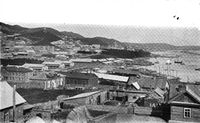
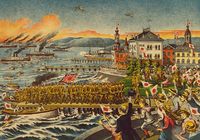
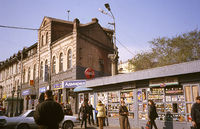
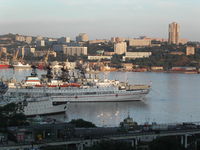
The city's population was 578,000 in 2010,[3] while the figure in the 2002 Census was 594,701. This is further down from 633,838 recorded in the 1989 Census. Ethnic Russians and Ukrainians make up the majority of the population.
From 1958 to 1991, only Soviet citizens were allowed to live in Vladivostok or visit it (and even then had to obtain an official permission). Before this closure, the city had large Korean[10] and Chinese populations.[11] Some Koreans who were deported during Stalin's rule from the Russian Far East have since returned, particularly to Vladivostok.[12]
Vladivostok has one of the largest Armenian communities in eastern Russia. There are a number of Armenian bakeries and restaurants in the city. There are also sizable communities of Chechens, Azeris and Tajiks in the city.[13] According to the latest statistics, there are currently about 100,000 Muslims living in the Russian Far East.[14]
Economy
The city's main industries are shipping, commercial fishing, and the naval base. Fishing accounts for almost four-fifths of Vladivostok's commercial production. Other food production totals 11%.
The main export items were fish, timber products, ferrous and non-ferrous metals, and ships. The main import items were food products, medicine, clothing, footwear, automobiles, household technical items, and ships.
Transportation
Vladivostok is the starting point of Ussuri Highway (M60) to Khabarovsk, the eastern most part of Trans-Siberian Highway that goes all the way to Moscow and Saint Petersburg via Novosibirsk. The other main highways go east to Nakhodka and south to Khasan.
The Trans-Siberian Railway was built to connect European Russia with Vladivostok, Russia's most important Pacific Ocean port. Finished in 1905, the rail line ran from Moscow to Vladivostok via several of Russia's main cities. Part of the railroad, known as the Chinese Eastern Line, crossed over into Manchuria, China, passing through Harbin, a major city in Manchuria. During the Soviet era, Vladivostok's status as a closed city meant that ferry-passenger tourists arriving from Japan to travel the Trans-Siberian railway westbound had to embark in Nakhodka. Today, Vladivostok serves as the main starting point for the Trans-Siberian portion of the Eurasian Land Bridge.
Air routes connect Vladivostok International Airport with Japan, People's Republic of China, North Korea, South Korea and Vietnam. It is possible to get to Vladivostok from several of the larger cities in Russia. Regular flights to Seattle, Washington were available in the 1990s but have been canceled since. Vladivostok Air resumed flying to Anchorage, Alaska in July 2008.
Urban transportation
On 28 June 1908, Vladivostok's first tram line was started along Svetlanskaya Street from the railway station in Lugovaya Street. On 9 October 1912, the first wooden cars manufactured in Belgium entered service. Today, Vladivostok's means of public transportation include trolleybus, bus, tram, train, funicular, ferryboat and cutter. The main urban traffic lines are City Center—Vtoraya Rechka, City Center—Pervaya Rechka—3ya Rabochaya—Balyayeva, and City Center—Lugovaya Street.
Education
Vladivostok is home to numerous educational institutions, including seven universities:
- Far Eastern National University (Дальневосточный государственный университет, or ДВГУ),
- Far Eastern State Technical University (Дальневосточный государственный технический университет имени Куйбышева or ДВГТУ),
- Marine State University (Морской государственный университет имени адмирала Г.И. Невельского),
- Far Eastern State Technical Fisheries University (Дальневосточный государственный технический рыбохозяйственный университет or Дальрыбвтуз),
- Vladivostok State University of Economics and Service (Владивостокский государственный университет экономики и сервиса or ВГУЭС),
- Vladivostok State Medical University (Владивостокский государственный медицинский университет), and
- Pacific State University of Economics (Тихоокеанский государственный экономический университет).
The Presidium of the Far Eastern Division of the Russian Academy of Sciences (ДВО РАН) as well as ten of its research institutes are also located in Vladivostok, as is the Pacific Research Institute of Fisheries and Oceanography (Тихоокеанский научно-исследовательский рыбохозяйственный центр or ТИНРО).
Media
Over fifty newspapers and regional editions to Moscow publications are issued in Vladivostok. The largest newspaper of the Primorsky Krai and the whole Russian Far East is Vladivostok with a circulation of 124,000 copies at the beginning of 1996. Its founder, joint-stock company Vladivostok-News, also issues a weekly English-language newspaper Vladivostok News. Another source of information on the city is the online daily Vladivostok Times. The subjects of the publications issued in these newspapers vary from information around Vladivostok and Primorye to major international events. Newspaper Zolotoy Rog (Golden Horn) gives every detail of economic news. Entertainment materials and cultural news constitute a larger part of Novosti (News) newspaper which is the most popular among Primorye's young people. Also, new online mass media about Russian Far East for foreigners Far East Times. This source invites everyone to take part in informational support of RFE for visitors, travellers and businessmen.
As of 2006, there are fourteen channels broadcasting. They are Channel One, RTR, OTV-Prim, Rambler, STS, TNT, MTV Russia, Muz-TV, Kultura, Ren-TV, NTV, DTV Viasat.
As of 1999, there are also seven radio stations, the most popular being 24-hour VBC (612 kHz, 101.7 MHz) and Europa+ (738 kHz, 104.2 MHz). Europa+ normally broadcasts popular modern British-American music, while the ratio of Russian and foreign songs over VBC is fifty-fifty. Every hour one can hear local news over these radio stations. Radio Vladivostok (1098 kHz) operates from 06:00 till 01:00. It broadcasts several special programs which are devoted to the music of the 1950s-1980s as well as New Age.
The Russian rock band, Mumiy Troll (Мумий Тролль), hails from Vladivostok and frequently puts on shows there. In addition, the city played host to the now-legendary "VladiROCKstok" International Music Festival in September 1996. Hosted by the Mayor and Governor, and organized by two young American expatriates, the festival drew nearly 10,000 people and top-tier musical acts from St. Petersburg (Akvarium and DDT (band)) and Seattle (Supersuckers, Goodness (band)), as well as several leading local bands.
It is the nearest city to the massive Sikhote-Alin Meteorite, which fell on February 12, 1947, in the Sikhote-Alin Mountains, approximately 440 km northeast of Vladivostok.
Pollution
Two thirds of Vladivostok's suburbs are so polluted that living in them is classified as a health hazard, according to the local ecological specialists, Ecocenter. Some areas, such as those near the printing works in Pokrovsky Park and the Far Eastern National University campus, are so polluted that they are defined as ecological disaster zones. Only a few areas have permissible levels of contamination. Professor Boris Preobrazhensky, an eco-scientist at the Pacific Institute of Geography said that there was nowhere in the area that was really healthy to live in.
The Ecocenter report has taken ten years to compile and is believed to be the most comprehensive of its kind. It was based on analysis of over 30,000 samples of water, snow, soil, air and human tissues taken between 1985 and 1993. Samples showed significant rises over that period in the levels of heavy metals, such as cadmium, zirconium, cobalt, arsenic, and mercury, which severely affect the respiratory and nervous systems.
The pollution has a number of causes, according to Ecocenter geo-chemical expert Sergey Shlykov. Vladivostok has about 80 industrial sites, which may not be many compared to Russia's most industrialized areas, but those around the city are particularly environmentally unfriendly, such as shipbuilding and repairing, power stations, printing, fur farming and mining. In addition, Vladivostok has a particularly vulnerable geography which compounds the effect of the pollution. Winds cannot clear pollution from some of the most densely populated areas around the Pervaya and Vtoraya Rechka as they sit in basins which the winds blow over. In addition, there is little snow in winter and no leaves or grass to catch the dust to make it settle down.[15]
Sports
Vladivostok is home to the football club FC Luch-Energiya Vladivostok, who play in the Russian First Division, and basketball club Spartak Primorje, who play in the Russian Basketball Super League.
International relations
Twin towns — sister cities
Vladivostok is a sister city of:
Notable people
- Igor Ansoff, mathematician
- Vladimir Arsenyev, explorer
- Feliks Gromov, admiral
- Ksenia Kahnovich, model
- Eugene Kozlovsky, writer
- Igor Kunitsyn, tennis player
- Elmar Lohk, architect
- Yul Brynner film actor
- Mary Losseff, singer and film actress
- Vladimir Nikolayev, former mayor
- birthplace of Natalia Pogonina, chess player
- Anna Shchetinina, world's first female captain of an ocean-going ship
- Igor Tamm, physicist
- Alexey Volkonsky, canoeist
- Victor Dmitrievich Zotov, botanist
- Mumiy Troll, Russian rock group:
- Ilia Lagutenko
- Oleg Pungin
- Eugene "Sdwig" Zvidionny
- Svoy, musician
- Nikolai Dubinin Russian biologist and academician
- Elena Peredkova Famous Chef
See also
- 32nd Rifle Division
- Russian Far East
Elena Peredkova
References
Bibliography
- Faulstich, Edith. M. "The Siberian Sojourn" Yonkers, N.Y. (1972–1977)
- Poznyak, Tatyana Z. 2004. Foreign Citizens in the Cities of the Russian Far East (the second half of the XIX - XX centuries). Vladivostok: Dalnauka, 2004. 316 p. (ISBN 5-8044-0461-X).
- Stephan, John. 1994. The Far East a History. Stanford: Stanford University Press, 1994. 481 p.
- Trofimov, Vladimir et al., 1992, Old Vladivostok. Utro Rossii Vladivostok, ISBN 5-87080-004-8
Notes
- ↑ Федеральная служба государственной статистики (Federal State Statistics Service) (2004-05-21). "Численность населения России, субъектов Российской Федерации в составе федеральных округов, районов, городских поселений, сельских населённых пунктов – районных центров и сельских населённых пунктов с населением 3 тысячи и более человек (Population of Russia, its federal districts, federal subjects, districts, urban localities, rural localities—administrative centers, and rural localities with population of over 3,000)" (in Russian). Всероссийская перепись населения 2002 года (All-Russia Population Census of 2002). Federal State Statistics Service. http://perepis2002.ru/ct/html/TOM_01_04_1.htm. Retrieved 2009-08-19.
- ↑ The value of density was calculated automatically by dividing the 2002 Census population by the area specified in the infobox. Please note that this value may not be accurate as the area specified in the infobox does not necessarily correspond to the area of the entity proper or is reported for the same year as the Census (2002).
- ↑ 3.0 3.1 3.2 Russia Analytical Digest (Institute of History, University of Basel, Basel, Switzerland) (82): 9-12. 2010-07-12. http://kms1.isn.ethz.ch/serviceengine/Files/ISN/118673/ipublicationdocument_singledocument/56406c10-2faa-4bb1-98dd-189045b0b62b/en/Russian_Analytical_Digest_82.pdf.
- ↑ Example at 中国驻符拉迪沃斯托克领事办公室正式开馆 (Chinese)
- ↑ National Institute for Compilation and Translation Academic Noun Search (Chinese)
- ↑ Benjamin Isitt, "Mutiny from Victoria to Vladivostok, December 1918," Canadian Historical Review, 87:2 (June 2006)
- ↑ "Car duty protests challenge Russia's Putin" REUTERS Dec 16. 2008
- ↑ Stalin-era mass grave yields tons of bones Reuters. June 9, 2010
- ↑ 9.0 9.1 "Pogoda.ru.net" (in Russian). http://pogoda.ru.net/climate/31960.htm. Retrieved September 8, 2007.
- ↑ Most Holy Mother of God, Vladivostok
- ↑ Vladivostok
- ↑ Coming home
- ↑ Russian Far East: Crime Central
- ↑ Mosque and chapel to preach tolerance – Vladivostok News
- ↑ B. V. Preobrazhensky, A. I. Burago, S. A. Shlykov. Primorye Ecology. Ecological Situation. Contamination of Sea and Water
External links
| Wikinews has news related to:
Владивосток
|
- Vladivostok Map (IE 5.0+)
- Historical Map of Vladivostok (1912), Perry-Castañeda Library Map Collection, University of Texas, Austin.
- Siberian Expedition website, by Benjamin Isitt
- Katauri Interactive
- Economy of Vladivostok
|
|||||||||||||||||
|
|||||||||||